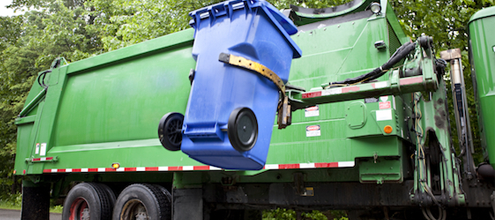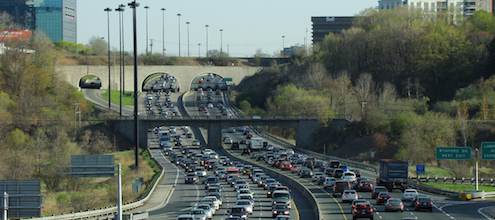
If you produce less garbage, you should pay less
Ecofiscal’s report on solid waste management (released last month) has a single idea: market-based policies can improve how we manage our solid waste in Canada and can save taxpayers money. In my last blog, I described six big problems that make waste markets inefficient and costly. This blog tackles the first problem: that most Canadian households don’t pay directly to have their waste collected and managed. The solution? Municipal “pay-as-you-throw” programs (PAYT for short).
PAYT programs change how we pay for garbage collection
Let’s start with how PAYT works. Most households in Canada pay for garbage collection through property taxes or flat monthly fees. Neither of these approaches, however, draw a connection between how much waste a household generates and how much they ultimately pay. All else being equal, households that put out 10 bags of trash pay the same as households that put out one bag.
PAYT programs ensure that those who generate less waste, pay less. Some PAYT programs require households to pre-purchase tags for each garbage bag put at the curb; others charge households more for bigger garbage bins. The underlying principle is the same as other services such as cellphone and internet plans or electricity utilities: if you use more of the service, you pay more.
The last national survey from 2005 found that fewer than 200 municipalities (less than 5% of all municipalities) used PAYT programs to finance garbage collection and disposal services. And while numerous municipalities have implemented PAYT since then—most recently, the City of Saskatoon—it’s clear that more communities could benefit by making the switch.
The benefits of PAYT programs
Changing how we pay for garbage collection can make our waste systems markedly more efficient.
First, PAYT saves money by encouraging households to divert more waste from landfills. By giving residents an incentive to make better use of recycling and organics programs (now the norm), PAYT can help extend the life of municipal landfills and defer the need to build expensive new ones. The City of Saskatoon, for example, estimates the combination of PAYT and organics collection could extend the life of it’s landfill by an additional 23 years, saving taxpayers about $5 million each year. Less landfilled waste also helps reduce environmental costs, such as methane emissions, unpleasant smells and sounds, and contamination risks to groundwater and soil.
Second, PAYT is a fairer way to charge for the service. When municipalities fund garbage collection through property taxes and fixed monthly fees, households that generate less waste end up subsidizing those that generate a lot. PAYT can also allow municipalities to reduce property taxes by an equivalent amount or eliminate flat monthly fees entirely.
Finally, the revenues from PAYT help municipal waste departments plan for the long term. Unlike property taxes, all revenues generated from PAYT programs must go back into funding the service. This means waste departments no longer have to compete for funding with other (often sexier) services, like recreation centres, parks, and roads. This improves revenue stability and ensures that municipalities can keep their infrastructure in good shape.
PAYT in Action (I): Beaconsfield, QC
But enough theory. Which municipalities use PAYT? And do they actually see the benefits?
The City of Beaconsfield, on the Island of Montreal (pop., 14,000), provides one of the best examples in Canada. Prior to the switch, Beaconsfield was one of the biggest generators of garbage on the Island. The City charged residents for waste management collection through an annual fixed fee. In 2016, however, Beaconsfield started charging households an annual fixed fee based on bin size (between $152 to $162) and a variable fee ($0.40 to $1.21) each time a bin is collected.
The results have been dramatic. Despite charging such a nominal amount, landfilled garbage in 2016 decreased by 51% per person relative to 2013. In 2016, Beaconsfield produced the lowest garbage per capita out of the 33 municipalities and boroughs on the Island.
Beaconsfield’s PAYT program has also reduced costs for government and taxpayers. In the first year, the cost for garbage collection and transport dropped by over $200,000. Nearly 80% of residents pay less than before the PAYT program because they put their bins out less frequently for collection.
PAYT in Action (II): Natick, Massachusetts
We go south of the border to Natick, MA, for our second example. A small suburb outside of Boston (pop., 34,000), Natick implemented its PAYT program due to budgetary concerns. Funding for waste management from the state was being cut back, forcing the town to find cost savings.
Natick switch from property taxes to PAYT in 2004 and uses a slightly different approach than Beaconsfield. Instead of getting residents to choose between different bin sizes, residents pre-purchase garbage bags offered in two different sizes. Bigger bags cost more than smaller ones.
Such a simple switch has produced measurable results. The program has helped reduce garbage volumes by 40% and increased recycling by 20% (the remainder is presumably from diverting more organics). The program has also saved the city a combined $3.5 million in tipping fees at the (privately-owned) landfill and has significantly reduced greenhouse gas emissions.
Notably, public support for PAYT in Natick has grown. The program faced serious political backlash when it was first implemented; years later, however, 72% of voters wanted to keep it.
Finding efficiencies in your trash can
Switching to PAYT can be challenging, not least because it makes the costs of garbage collection more visible to households. But that’s exactly the point. Designed well, they encourage households to reduce their waste, saving landfill space and deferring the need to build expensive new ones. PAYT programs can also be paired with a reduction in property taxes, which can make it more palatable.
The path toward greater efficiency starts in the trash bins under our sinks and counters. But it doesn’t end there. The next few blogs in our waste series will look at other policies that can help save our waste systems money.
Online course: Municipal market-based tools for sustainable development Sign up now for this new and unique Ecofiscal course, designed for municipal employees.




2 comments
On the surface of it, PAYT sounds like an excellent system but I would like to know if roadside waste has increased outside their area. In our neck of the woods, rural Ontario, we find bags of garbage, furniture, appliances, building materials – you name it – discarded on our roadsides. My fear is that going to a PAYT system we would see an increase in this dumping. Those under PAYT will reap the benefits while we have to pay for the removal of roadside waste.
Hi Jan, thanks for your comment. You’re right in that illegal dumping is already a problem in most (if not all) municipalities. And it’s reasonable to think that making the price more visible to households will make things worse. However, available evidence suggests that concerns about illegal dumping may be overstated. About one-fifth of U.S. communities with PAYT programs experienced an initial increase in illegal dumping that subsided after a few months. In Ontario, communities with PAYT noted a small increase in illegal dumping during the first few months, but over time households became accustomed to the programs and illegal dumping decreased. Illegal dumping is also less common when residents have substitutes to waste disposal, such as recycling and compost programs.
Finally, communities can design PAYT programs to specifically reduce the risk of illegal dumping. For example, communities that charge residents each time they put their bin at the curb (like Beaconsfield) can include one free pickup per month. Municipalities can also increase the frequency of bulky item collection (like mattresses or other furniture).
Comments are closed.